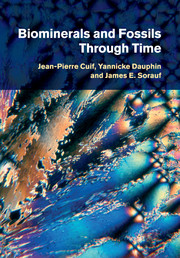Book contents
- Frontmatter
- Contents
- Preface
- Introduction: Milestones in the study of biominerals
- 1 The concept of microstructural sequence exemplified by mollusc shells and coral skeletons
- 2 Compositional data on mollusc shells and coral skeletons
- 3 Origin of microstructural diversity
- 4 Diversity of structural patterns and growth modes in skeletal Ca-carbonate of some plants and animals
- 5 Connecting the Layered Growth and Crystallization model to chemical and physiological approaches
- 6 Microcrystalline and amorphous biominerals in bones, teeth, and siliceous structures
- 7 Collecting better data from the fossil record through the critical analysis of fossilized biominerals
- 8 Results and perspectives
- List of references
- Name index
- Subject index
4 - Diversity of structural patterns and growth modes in skeletal Ca-carbonate of some plants and animals
The contrast between architectural and microstructural diversity at the macroscale and similarities at the submicrometer scale
Published online by Cambridge University Press: 10 January 2011
- Frontmatter
- Contents
- Preface
- Introduction: Milestones in the study of biominerals
- 1 The concept of microstructural sequence exemplified by mollusc shells and coral skeletons
- 2 Compositional data on mollusc shells and coral skeletons
- 3 Origin of microstructural diversity
- 4 Diversity of structural patterns and growth modes in skeletal Ca-carbonate of some plants and animals
- 5 Connecting the Layered Growth and Crystallization model to chemical and physiological approaches
- 6 Microcrystalline and amorphous biominerals in bones, teeth, and siliceous structures
- 7 Collecting better data from the fossil record through the critical analysis of fossilized biominerals
- 8 Results and perspectives
- List of references
- Name index
- Subject index
Summary
In addition to molluscs and corals, two groups that contain highly diversified contributors to biogenic carbonate sediments in present-day shallow seawaters, many other organisms are also important Ca-carbonate producers. For some of them, such as the Echinodermata, their present role only poorly reflects their former importance during older geological periods. This chapter, by no means exhaustive, aims to present some of their diverse three-dimensional organizations, focusing on the fine structure of calcareous hard parts. The underlying objective is first, to provide some insight into recognition of the main categories of Ca-carbonate producers of carbonate-dominated sedimentary facies. Additionally, since knowledge of diagenetic change is an obvious prerequisite for obtaining reliable evaluation of characteristics in fossilized biogenic materials, knowledge of the initial state of these Ca-carbonate materials provides the reader with a basis for comparison.
Benthic algae
Very few algae have developed calcareous biomineralization, but they play an important geological role: only two families of the Chlorophyceae and two others among the Rhodophyceae. From a viewpoint of methods, this calcareous mineralization provides remarkable contrasts between the two groups, as follows:
(1) They are mineralogical opposites, as calcifying Chlorophyceae virtually always produce aragonite, while the majority of the mineralizing Rhodophyceae form calcite (although Peysnella and related types utilize aragonite);
(2) They also are structural opposites, as the Chlorophyceae produce carbonate external to their tissues, while the Rhodophyceae develop calcification at the level of cellular membranes;
[…]
Information
- Type
- Chapter
- Information
- Biominerals and Fossils Through Time , pp. 185 - 276Publisher: Cambridge University PressPrint publication year: 2010
Accessibility standard: Unknown
Why this information is here
This section outlines the accessibility features of this content - including support for screen readers, full keyboard navigation and high-contrast display options. This may not be relevant for you.Accessibility Information
- 2
- Cited by
